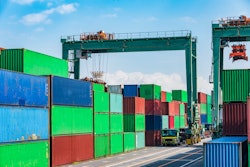
On Aug. 22, two of Canada’s major freight railroads -- Canadian National (CN) and Canadian Pacific Kansas City Southern (CPKC) -- shut down operations, according to management of the two companies, locking out 9,000 members of the Teamsters union who operate the trains.
According to CNN, nearly one-third of the freight handled by the two railroads crosses the U.S.-Canadian border, which means, the shutdown could disrupt operations in a number of U.S. industries, including agriculture, automotive, home building, energy and more.
Yet, less than 24 hours later, CN and CPKC reached an agreement with the Teamsters labor union and restarted railway operations. However the agreement didn't come until after the Canadian Minister of Labour announced plans to exercise his authority under Section 107 of the Canada Labour Code, which directs the Canada Industrial Relations Board (CIRB) to impose final binding arbitration and for railway operations to resume.
What does this mean for the future of U.S. supply chains?
Food Logistics and Supply & Demand Chain Executive's editor-in-chief Marina Mayer talks with several industry experts on what's at stake for now and what this means for the future of U.S. supply chains, especially as the industry begins to enter its peak season shipping.
In response to the shutdown, carriers started to divert cargo from Canada’s West Coast ports in anticipation of the potential rail strike. The number of vessel arrivals at container terminals in the Port of Vancouver dropped from 73 to 61 for the second week of August, the second lowest number of arrivals throughout 2024, according to Everstream Analytics. The most impacted goods shipped via rail would be fertilizer, iron ore, grain, cement, salt, potash, coal, cars, wood/timber as well as containers loaded with consumer goods or intermediate parts.
As the strike continues, wait times will increase for all rail yards not only in Canada, but also in yards holding freight destined for Canada, according to project44 data.
"The impending rail strike involving Canadian National Rail Line (CN) and Canadian Pacific Kansas City (CPKC) is poised to significantly disrupt supply chains across North America. Key industries such as crude oil, minerals, lumber, automobiles, and consumer goods are particularly vulnerable due to their reliance on rail for efficient transport of large volumes. The shift to alternative transportation methods, like trucking, will likely result in increased costs, delays, and potential shortages. This also comes shortly before peak shopping seasons. Peak season has already started for ocean transit, and as this freight lands, it is unlikely that the truckload market will be able to absorb the volume destined for rail without delays and expedition charges," according to project44. "As ocean carriers also adjust by diverting cargo, the ripple effects of the strike will extend beyond rail, affecting the broader logistics landscape. The situation highlights the critical role of rail infrastructure in North American trade and the far-reaching impacts of labor disputes on the economy."
What's more, CMA CGM issued a notice detailing several measures, including potential rerouting of vessels to U.S. ports and restrictions on rail shipments. The company also implemented embargoes on specific intermodal shipments, including hazardous materials and temperature-controlled containers, across their network.
"The possibility of simultaneous strikes at U.S. ports and Canadian railways present a perfect storm for North American trade," says Christian Roeloffs, co-founder and CEO of Container xChange. “In the mid-term, we could face increased volatility in freight rates, with potential spikes driven by supply chain bottlenecks and congestion. Shippers and cargo owners should prepare for higher costs and possible delays as the industry adjusts to these challenges.”
Many of Canada's key exports, such as grain, potash, coal, and manufactured goods, are transported by rail to ports for shipment overseas. A rail strike would disrupt the flow of these goods, leading to delays in exports and possibly causing congestion at ports as containers pile up, according to Roeloffs. Similarly, imported goods that arrive at Canadian ports often rely on railways to be distributed to various parts of the country. A strike could lead to delays in getting these goods to their final destinations, causing supply chain bottlenecks and increased costs for businesses.
"With a $1 billion of freight transported via rail in Canada per day, the shutdown will have a supply side impact on Canadian businesses. Small businesses in retail, agriculture, and distribution will likely be the most impacted at first, as they have less supply-side flexibility than larger players such as Wal-Mart. They will either have too much inventory due to stockpiling or not enough due to shortages. That will negatively impact cash flow and likely result in the stretching of payments to their suppliers. Longer term, we will likely see the impact on the auto-sector and exporters, especially in western Canada, who rely heavily on rail. While truckers may see some short-term benefits, there are many types of goods that are simply not suited to be trucked great distances overland. Therefore, the impact will likely be minimal. We help companies deal with unexpected events that lead to payment defaults. Typically, we see an increase in demand for our trade credit insurance products when these types of situations arise," says David Dienesch, CEO and chief agent at Allianz Trade in Canada.
And, there is no clear indication of how long this could last.
"Both parties are continuing to converse and look for a resolution. It could come as early as sometime today, or could bleed into the upcoming days/weeks. Regarding bordering states, we're not seeing any meaningful impacts yet. However, if the strike goes on longer, we could see a decrease in certain commodities in Northern states, such as auto/agricultural and temp-control shipments," says David Spencer, VP of market intelligence, Arrive Logistics.
"Cross-border market disruption is harder to predict because its impact is more secondary. Carriers running cross-border lanes are being offered higher-paying loads within Canada, leading outbound capacity to be absorbed by carriers switching to intra-Canada routes to capitalize on the inflated spot market. As outbound capacity diminishes, rates will start to rise. We have already seen this as of yesterday and today, and we expect it to continue as the intra-Canada market heats up," adds Noah Sidenberg, general manager of Canada sales and operations, Arrive Logistics.
*This is an ongoing story. Check back for continued updates and interviews from key sources in the supply chain and logistics sector.



![Pros To Know 2026 [color]](https://img.sdcexec.com/mindful/acbm/workspaces/default/uploads/2025/08/prostoknow-2026-color.mduFvhpgMk.png?auto=format%2Ccompress&bg=fff&fill-color=fff&fit=fill&h=100&q=70&w=100)







![Pros To Know 2026 [color]](https://img.sdcexec.com/mindful/acbm/workspaces/default/uploads/2025/08/prostoknow-2026-color.mduFvhpgMk.png?ar=16%3A9&auto=format%2Ccompress&bg=fff&fill-color=fff&fit=fill&h=135&q=70&w=240)








